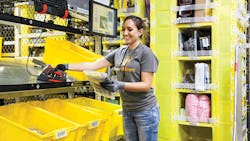Omni-channel strategies differ in the emphasis they place on the roles of distribution centers and stores for e-commerce fulfillment. Regardless of which is primary in fulfilling e-commerce orders, the definition of the warehouse is changing. For distribution professionals, there are a number of implications—including the need to treat stores like part of their warehouse network.
Retailers like Macy's are using omni-channel to make sure they don't miss an order, says George Swartz, a director who specializes in the retail practice for Sedlak Management Consultants. Their primary approach is to fulfill e-commerce orders from the distribution center (DC). If the DC can't meet the service requirement, an order can be filled from store inventory.
This may involve little or no change at the e-commerce fulfillment DC, but for the store portion, it has a number of implications. You need good store-level visibility, Swartz comments. That's also true of the other strategies that involve the stores in e-commerce fulfillment. The retailer has to have the technology to be able to see all of its inventory, agrees Curt Bimschleger, SVP of retail logistics for GENCO.
That technology includes middle-level systems that manage distributed order management (or, to use Oracle's term, distribution order orchestration), says Swartz, pointing to companies like Manhattan Associates. These systems look at all inventory and optimize the fulfillment based on the business rules the user has set, he explains. Those rules can favor service or cost, but they will certainly try to strike a reasonable balance between the two.
But, when it comes to inventory accuracy at the store level (backroom and sales floor), the problem with stores right now is inventory accuracy, continues Bimschleger. For example, the store may need an hour or two for an e-commerce order scheduled for in-store pickup to confirm it has the item and get the product to the customer pickup desk. "Accuracy is getting better, but it is nowhere near as accurate as the distribution center," he continues. "I'm hearing percentages in the high 60s to mid 70s for accuracy vs. a DC at 99%-plus accuracy."
As some retailers have moved towards a supply chain approach to omni-channel, they have bumped up against the store inventory issue and have had to focus first on improving store inventory accuracy and store discipline. Some retailers first have to focus on point-of-sale (POS) systems to improve the accuracy and speed of collecting and communicating that data. This still won't account for the customers who are still in the store with products they picked up from the shelf but have not yet purchased. Nor will it account for the items abandoned by customers who changed their minds about the purchase. Those items are not on the shelf and they are not at the checkout.
Looking at Data
When retailers start looking at inventory in a single bucket, the allocation rules governing that inventory become important, points out Judy Craig, vice president at Kenco. Swartz sheds some light on part of the issue. He notes a handful of retailers, including Ann Inc., parent of Ann Taylor retail stores, are driving as much e-commerce fulfillment as possible to the stores.
For some retailers, this presented problems because their sales commissions were set up in a way that did not give stores credit for e-commerce orders they might fulfill. A common response was that stores protected inventory for themselves. Ann Inc. took steps to ensure stores got credit for any sales or orders they completed, whether they came from an online order or a walk-in customer.
Starting with the DC
While much of the discussion of supporting omni-channel distribution focuses at the store level, there are also issues at the warehouse or DC level. For many retailers, DC investments in the last five years or so focused on e-commerce fulfillment centers—either stand alone or as a separate operation in a facility that also handles store replenishment. Among those investments are pick towers, take away conveyors and sorters designed to handle "each" picks, notes Swartz.
Picking and packing orders of single items may not be new, but one of the trends in e-commerce (and its subset mobile commerce, or m-commerce) has been a shift towards single line single orders, Swartz continues.
Walking through an example with Bimschleger, he describes an e-commerce customer who may be sitting on a city rapid transit train headed home who decides to order a new cable for their phone. The customer places the order using a smartphone or tablet. The next day, that same customer remembers s/he also wanted to order a case for the phone and places that order. By the following day, those orders have been picked and shipped as two separate parcels. "If you're an Amazon Prime member [which means there is no additional shipping charge]," Bimschleger continues, "people are buying four or five times a day."
Many companies have elected to outsource e-commerce fulfillment to a third-party logistics provider (3PL), in part because of the infrastructure needed for the type of pick and pack operation it needs. But as e-commerce grows, many companies are looking at blended operations which they may operate or contract to a 3PL.
Bimschleger says that e-commerce represented about $400 to $500 billion in 2014 and mobile commerce, as a subset, was about 15% to 20% of that total. That's one reason the omni-channel approach is on the rise—when that customer clicks "buy" they could receive a message that the item is available in a store just three miles from them and they can arrange for a pre-paid, in-store pickup, or the item can be shipped to arrive in two days free of charge or next day for $8.00.
Where the volumes or scale reach a level that e-commerce can be brought into the core operation, some companies are moving towards a blended operation bringing all five types of distribution under one roof—wholesale, business to business, returns, e-commerce and store replenishment, notes Craig. However, some keep the e-commerce with a 3PL, she adds, possibly because of the each-pick infrastructure. This includes not only how the physical operations are laid out but also can involve the order management and call center components.
Putting e-commerce under the same roof as store replenishment definitely involves some retooling, says Swartz. The types of sorters used for e-commerce don't fit the model for replenishment. The e-commerce operations are often voice-pick with take-away conveyors where the replenishment operations have more automation and high-speed conveyors.
Craig comments that the product mix is a critical part of the decision on the type of distribution center network. Companies with high numbers of low-weight SKUs may be more likely to opt for a single, large fulfillment center. Those with more of a high-cube line of products could look for more DCs located closer to the markets. Inventory and cost of labor are important, she continues, but the most important factor will be transportation cost.
The Role of the Store
That's why a big part of the omni-channel discussion focuses on the role of the store. A retailer like The Limited with good geographic coverage and hundreds of stores might opt to put fulfillment operations in some of its stores, suggests Swartz. It wouldn't want to put e-commerce fulfillment in all of the stores because of the infrastructure and labor requirements. It might select two stores per market, Swartz offers, and have a full-time fulfillment specialist in the locations where there is sufficient volume and backroom space to handle the inventory.
He points to some other models like the JC Penney "jeans bar," which he describes as a mini warehouse on the sales floor. Store workers could "shop" the inventory on the sales floor, picking orders off the rack and taking them to a packing station for shipment to the customer or to a customer pickup point for in-store pickup.
Whether the strategy involves more regional DCs doing fulfillment closer to end markets or using select stores as pick/pack/ship locations, one of the omni-channel trends is reducing transit time and transportation cost by filling orders within a next-day "zone 1"delivery area.
Meanwhile, many retailers are strongly encouraging customers to purchase online and pickup in the store (known as POPIS). One advantage to this, Swartz adds, is that it provides same-day delivery. Best Buy, he says, did a good job with this during the last two Christmas seasons.
Craig agrees. "If you're going to compete with Amazon Prime's two-day delivery, you need locations that can serve your customer base—95% of that customer base—in a two- to three-day window." Those facilities may be a smaller regional DC or a store-as-warehouse location.
Another problem is dealing with returns, Bimschleger notes. Distribution centers are already dealing with vendor returns. Typically, he says, e-commerce returns can go back into stock. Retailers would prefer to drive as many e-commerce returns as possible through the stores where the single returns can be put into store inventory or consolidated and sent to the DC with vendor returns and use the reverse processes already in place for return-to-vendor goods.
At a London mall, shopping center operator The Westfield Group set up a centralized pickup center for e-commerce orders and also provided a drop center for returns, says Swartz. Both were a convenience for consumers who could not only purchase online and pick up in-store, but they could order from multiple retailers and pick up those orders at the pickup center. Returns were similarly simplified. Westfield had to get agreement from multiple retailers to use the facility and while it was located at an outside corner of the mall, the retailers still managed to get increased foot traffic.
Ultimately, for distribution executives, perhaps the biggest challenge will be convincing others along the supply chain that their omni-channel strategy includes a new concept—the store as warehouse—and a new set of disciplines and tactics.
Perry A. Trunick is a supply chain industry journalist and consultant with 35 years of experience. He is also a member of the adjunct faculty of the Operations and Supply Management Department of the Monte Ahuja School of Business at Cleveland State University.

